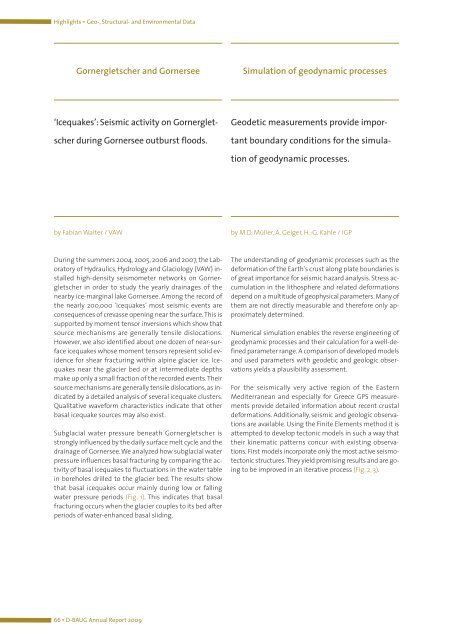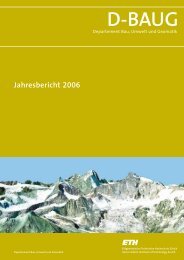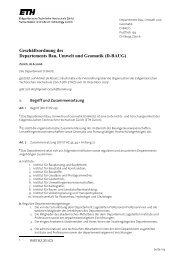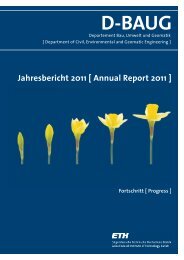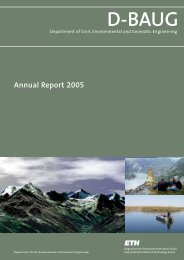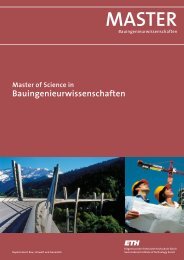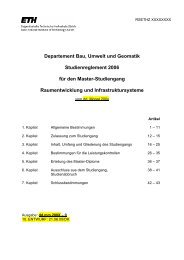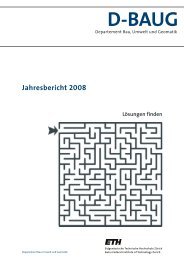D-BAUG - Departement Bau, Umwelt und Geomatik - ETH Zürich
D-BAUG - Departement Bau, Umwelt und Geomatik - ETH Zürich
D-BAUG - Departement Bau, Umwelt und Geomatik - ETH Zürich
Create successful ePaper yourself
Turn your PDF publications into a flip-book with our unique Google optimized e-Paper software.
Highlights ▪ Geo-, Structural- and Environmental Data<br />
Gornergletscher and Gornersee Simulation of geodynamic processes<br />
‘Icequakes’: Seismic activity on Gornerglet-<br />
scher during Gornersee outburst floods.<br />
During the summers 2004, 2005, 2006 and 2007, the Laboratory<br />
of Hydraulics, Hydrology and Glaciology (VAW) installed<br />
high-density seismometer networks on Gornergletscher<br />
in order to study the yearly drainages of the<br />
nearby ice-marginal lake Gornersee. Among the record of<br />
the nearly 200,000 'icequakes' most seismic events are<br />
consequences of crevasse opening near the surface.This is<br />
supported by moment tensor inversions which show that<br />
source mechanisms are generally tensile dislocations.<br />
However, we also identified about one dozen of near-surface<br />
icequakes whose moment tensors represent solid evidence<br />
for shear fracturing within alpine glacier ice. Icequakes<br />
near the glacier bed or at intermediate depths<br />
make up only a small fraction of the recorded events.Their<br />
source mechanisms are generally tensile dislocations, as indicated<br />
by a detailed analysis of several icequake clusters.<br />
Qualitative waveform characteristics indicate that other<br />
basal icequake sources may also exist.<br />
Subglacial water pressure beneath Gornergletscher is<br />
strongly influenced by the daily surface melt cycle and the<br />
drainage of Gornersee.We analyzed how subglacial water<br />
pressure influences basal fracturing by comparing the activity<br />
of basal icequakes to fluctuations in the water table<br />
in boreholes drilled to the glacier bed. The results show<br />
that basal icequakes occur mainly during low or falling<br />
water pressure periods (Fig. 1). This indicates that basal<br />
fracturing occurs when the glacier couples to its bed after<br />
periods of water-enhanced basal sliding.<br />
66 ▪ D-<strong>BAUG</strong> Annual Report 2009<br />
Geodetic measurements provide impor-<br />
tant bo<strong>und</strong>ary conditions for the simula-<br />
tion of geodynamic processes.<br />
by Fabian Walter / VAW by M.D. Müller, A. Geiger, H.-G. Kahle / IGP<br />
The <strong>und</strong>erstanding of geodynamic processes such as the<br />
deformation of the Earth's crust along plate bo<strong>und</strong>aries is<br />
of great importance for seismic hazard analysis. Stress accumulation<br />
in the lithosphere and related deformations<br />
depend on a multitude of geophysical parameters. Many of<br />
them are not directly measurable and therefore only approximately<br />
determined.<br />
Numerical simulation enables the reverse engineering of<br />
geodynamic processes and their calculation for a well-defined<br />
parameter range. A comparison of developed models<br />
and used parameters with geodetic and geologic observations<br />
yields a plausibility assessment.<br />
For the seismically very active region of the Eastern<br />
Mediterranean and especially for Greece GPS measurements<br />
provide detailed information about recent crustal<br />
deformations. Additionally, seismic and geologic observations<br />
are available. Using the Finite Elements method it is<br />
attempted to develop tectonic models in such a way that<br />
their kinematic patterns concur with existing observations.<br />
First models incorporate only the most active seismotectonic<br />
structures.They yield promising results and are going<br />
to be improved in an iterative process (Fig. 2, 3).


